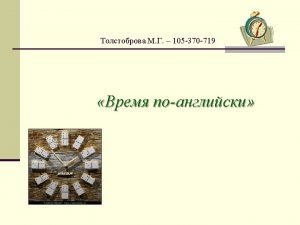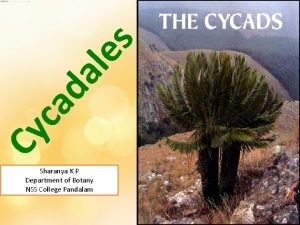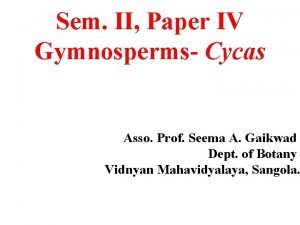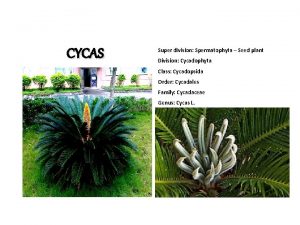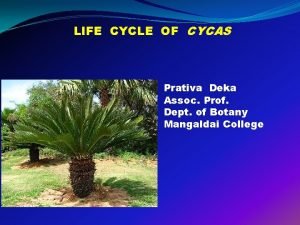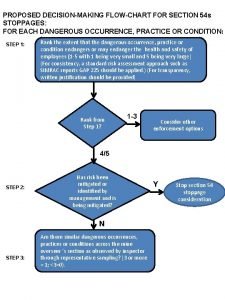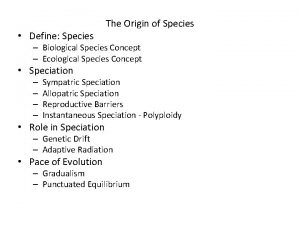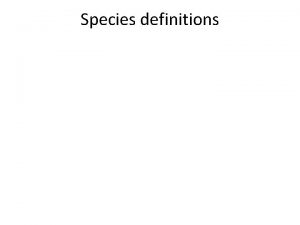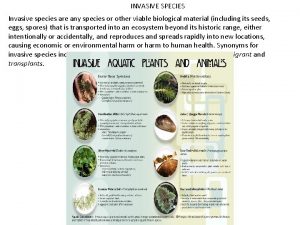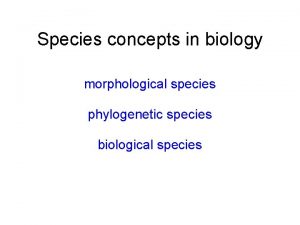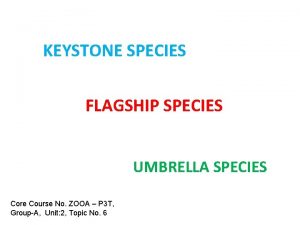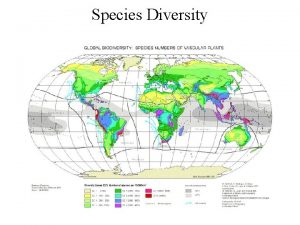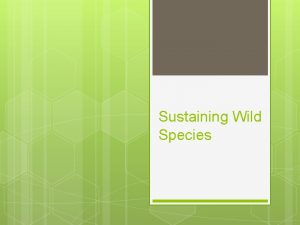Cycas Occurrence Sixteen species of Cycas are found


























- Slides: 26

Cycas

Occurrence: Sixteen species of Cycas are found in the tropical and subtropical parts of the earth. The name Cycas has been derived from a Greek word Kykas = Cocopalm. It is an evergreen plant. In India Cycas is represented by six species — C. revoluta, C. pectinata, C. siamensis, C. beddomei, C. rumphiand C. circinalis. Cycas revoluta is the most commonly cultivated species of Indian gardens. It also occurs in China, Africa, Nepal, Sri Lanka and Japan. Its natural habitat is in open, sunny, welldrained situations. It is a palm-like tree with size varies from 1 -2 meters. As it yields ‘sago’, from the mucilage in its main trunk. It is popularly called ‘sago palm’. Leaflets are 6 -8 mm broad with revolute margins.

CLASSIFICATION KINDOM- Plantea DIVISION- Cycadophta CLASS- Cycadopsida ORDER- Cycadales FAMILY- Cycadaceae GENUS- Cycas

THE PLANT BODY v. The Cycas plants are evergreen, slow-growing small trees resemble angiospermous palms in external appearance. v. The average height of the plant is 3 -5 m but some species attain 13 -20 m also. v. They are xerophytes and are long lived plant. v. Each plant consists of a thick unbranched columnar stem which bears a crown of large pinnately compound leaves. Such habit is called ARBORESCENT.

Morphology of ROOT of Cycas ØRoots are of two types, i. e. , normal tap root and coralloid root. ØTap root is positively geotropism, non -green, without root hair. It helps in anchorage and absorbs water and minerals. ØCoralloid roots are lateral branches of tap root. It grows first horizontally (diageotropic) then, repeatedly divide dichotomously, come out of the soil surface in the form of coral like mass.

Morphology of stem of cycas The stem is erect, columnar, woody and un-branched. It is covered with alternate whorls of leaf bases of foliage leaves and scale leaves. The stem apex bears a crown of leaves and sex organs at maturity.

Morphology of leaves of cycas Leaves are dimorphic i. e. 2 types, assimilatory or foliage leaves and scaly leaves or cataphylls. Both the leaf types are born at the stem apex in alternate spirals. Foliage leaves are large (1 -3 m), green, pinnately compound. Petiole has 2 rows of spines. Rachis bears 80 -100 pairs of pinnae or leaflets. Leaflets are sessile, elongated, tough, and lanceolate in shape with a spiny apex, revolute or smooth margins. Young leaves have circinate vernation like those of ferns and always covered with brown hairs called ramenta (Fig. 9. 3). Scale leaves are small, dry, brown, triangular leaves covered with ramenta. They are non- photosynthetic and

Anatomy-Root • • Young root shows typical structure like that of dicotyledonous root. Outermost layer, epiblema, enclosesthe parenchymatous cortex interspersedwith tannin cells and mucilage canal. Endodermis with casparian thickenings Pericycle is multilayred with thin cells having strach grains. Vascular tissue within is typically radial. Roots usually diarch to tetraarch. Vessels absent in vascular tissue. Pith reduced or absent.

Anatomy-Root • Older roots shows secondary growth. • Cambial ring is initiated between xylem and phloem and completed by differentiation in inner layer of pericycle adjacent to protoxylem elements. • These cambial cells are meristematic and add secondary xylem on the inside and secondary phloem towards cortex. • Lenticels are developed in old roots.

















 Antigentest åre
Antigentest åre Why is the saguaro cactus a keystone species
Why is the saguaro cactus a keystone species 8 past 12
8 past 12 The sixteen career clusters
The sixteen career clusters Jose trips over his untied shoelace
Jose trips over his untied shoelace The 16 point compass
The 16 point compass Sixteen securities inc
Sixteen securities inc Microsporophyll and megasporophyll of cycas
Microsporophyll and megasporophyll of cycas Xerophytic adaptation of cycas leaflet
Xerophytic adaptation of cycas leaflet Division spermatophyta
Division spermatophyta Cycas revoluta reproduction
Cycas revoluta reproduction Ginkgo biloba strobilus
Ginkgo biloba strobilus Cycas life cycle
Cycas life cycle Dangerous occurrence
Dangerous occurrence An occurrence at owl creek bridge pov
An occurrence at owl creek bridge pov Partial failure meaning
Partial failure meaning Co occurrence matrix example
Co occurrence matrix example Occurrence sampling
Occurrence sampling Annual exceedance probability vs return period
Annual exceedance probability vs return period Personification in an occurrence at owl creek bridge
Personification in an occurrence at owl creek bridge Gypsum occurrence
Gypsum occurrence Come to occurrence
Come to occurrence Recurring aspects of designs are called design
Recurring aspects of designs are called design Attributes cannot share a domain
Attributes cannot share a domain There will come soft rains climax
There will come soft rains climax Express action or state of being
Express action or state of being An occurrence at owl creek bridge comprehension questions
An occurrence at owl creek bridge comprehension questions


